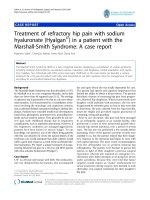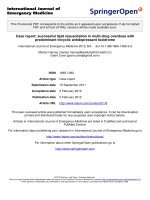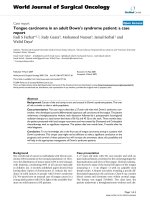Case report: Severe asymptomatic hyponatremia in Prader-Willi Syndrome
Bạn đang xem bản rút gọn của tài liệu. Xem và tải ngay bản đầy đủ của tài liệu tại đây (334.4 KB, 3 trang )
Landau et al. BMC Pediatrics (2016) 16:28
DOI 10.1186/s12887-016-0563-4
CASE REPORT
Open Access
Case report: severe asymptomatic
hyponatremia in Prader-Willi Syndrome
Daniel Landau1, Harry J. Hirsch2* and Varda Gross-Tsur2,3
Abstract
Background: Prader-Willi syndrome is a complex neurogenetic, multisystem disorder. Despite the variable endocrine
abnormalities and hypothalamic-pituitary axis dysfunction, hyponatremia has been reported in only a few PWS
patients. In previously reported PWS individuals, hyponatremia was associated with abnormal fluid intake or during
desmopressin treatment.
Case presentation: We describe an infant with Prader-Willi syndrome who had severe, prolonged asymptomatic
hyponatremia without a history of excessive fluid intake or desmopressin treatment. We compare the findings with
those of the few other reported cases and describe, for the first time, results of a hypertonic saline infusion test and
studies of adrenal cortical function.
Conclusion: Hyponatremia should be suspected in children with Prader-Willi syndrome, especially in infants with
severe failure to thrive. Further studies are needed to determine the pathophysiology of hyponatremia in this
syndrome.
Keywords: Prader-Willi syndrome (PWS), Hyponatremia, Anti-diuretic hormone (ADH), Adrenocortioctrophic
hormone (ACTH) test
Background
Prader-Willi syndrome (PWS) is a complex neurogenetic, multisystem disorder with a prevalence of 1/15,000
to 1/30,000, caused by lack of expression of genes on the
paternally inherited chromosome 15q11.2-q13. PWS is
characterized by dysmorphic features, hypotonia, cognitive
and behavioral abnormalities, impaired satiety response
leading to morbid obesity, and multiple endocrine
abnormalities including growth hormone deficiency,
hypogonadism, impaired glucose tolerance and diabetes
mellitus, and hypothyroidism [1]. Hypothalamic dysfunction has been implicated in many manifestations of
the syndrome. Hyponatremia has rarely been observed
despite the variable endocrine abnormalities, hypothalamicpituitary axis dysfunction, and abnormal eating behavior.
Studies of sodium homeostasis or adrenocortical function
in hyponatremic PWS children or adults have not been
previously described.
* Correspondence:
2
Neuropediatric Unit, Department of Pediatrics, Shaare Zedek Medical Center,
P.O.B 3235, Jerusalem 91031, Israel
Full list of author information is available at the end of the article
Case presentation
Our patient was diagnosed with PWS at the age of
3 weeks, based on the typical neonatal characteristics
including severe hypotonia, poor feeding due to inability to suck, dysmorphic features, and undescended testes. Genetic testing showed abnormal methylation and
confirmed the diagnosis of PWS due to deletion of paternal genes in chromosome 15q11-q13. The child was
discharged from the neonatal unit at the age of 3 weeks.
At home he was very weak, had a very poor appetite,
did not cry for food, took oral feeds very slowly, and
had very poor weight gain. Due to recurrent high fevers
up to 42 °C and an average temperature of 38–39 °C,
he was hospitalized several times with a diagnosis of
pyrexia of unknown origin. Treatment with antibiotics
was ineffective. A sleep study at age 10 months revealed
mild obstructive sleep apnea, with oxygen saturation
dropping to 70 % but a hypopnea/apnea index of only
two per hour. He was referred for adeno-tonsillectomy.
Routine pre-operative blood tests, at age 15 months
showed a serum sodium value of 118 meq/L. Sodium
values, measured three and 8 months previously, were
normal (135 meq/L). Parents denied use of medications
© 2016 Landau et al. Open Access This article is distributed under the terms of the Creative Commons Attribution 4.0
International License ( which permits unrestricted use, distribution, and
reproduction in any medium, provided you give appropriate credit to the original author(s) and the source, provide a link to
the Creative Commons license, and indicate if changes were made. The Creative Commons Public Domain Dedication waiver
( applies to the data made available in this article, unless otherwise stated.
Landau et al. BMC Pediatrics (2016) 16:28
or any recent diarrhea or vomiting. On admission, his
temperature was 38.4 °C; otherwise his vital signs were
normal. While awake, his oxygen saturation was 95 %
but dropped to 82 % while asleep. No evidence of respiratory distress was seen. His weight was 9.8 kg
(−0.84 SD) and length 75 cm (−1.05 SD). There were
no clinical signs of dehydration or edema. His fontanelle was not sunken, mucous membranes were moist,
and tears were seen on crying. He had bilateral undescended testes. Neurological exam showed head lag and
generalized hypotonia. Deep tendon reflexes were difficult to elicit. Eye movements were normal. He did not
crawl or sit. There were no focal neurologic signs.
A chest x-ray showed increased pulmonary markings,
but nasal washes for a panel of respiratory viruses were
negative. A complete blood count showed leukocytosis
(18.8×109/L) with a left shift (10.0×109/L neutrophils), but
blood cultures were negative. Serum sodium was
121 meq/L(121 mmol/l), potassium 4.8 meq/L (4.8 mmol/
l), chloride 89 meq/L (89 mmol/l), uric acid 2.9 mg/dL
(173 μmol/L), urea 17 mg/dL (3.03 mmol/L), creatinine
0.12 mg/dL (10.6 μmol/L), and glucose 104 mg/dL
(5.77 mmol/L). Serum osmolality was appropriately low,
260 mosm/L. On urinalysis, specific gravity was 1.015,
protein +2 and blood +1, but there was no proteinuria or
hematuria on repeated urinalyses. Urine osmolality (324
mosm/L) was inappropriately concentrated for the state of
serum hypo-osmolality. Urine sodium obtained after a
single 0.9 % NaCl intravenous bolus of 20 ml/kg was appropriately elevated (80 meq/L (80 mmol/l)), suggesting
lack of total body sodium deficit. Thyroid function studies
showed a free thyroxine of 1.0 ng/dL (normal: 0.8–1.5)
(12.9 pmol/L) and mildly elevated TSH (6.1 mIU/L,
normal 0.39–4). Morning cortisol was normal (22.6 ug/
dL) (623 nmol/L). Brain MRI showed mild external hydrocephalus but the hypothalamus and pituitary regions were
normal.
The child did not exhibit any change in his neurological
condition while hyponatremic. He was treated with supplemental oxygen, a short course of oral amoxicillin and
fluid restriction. Serum sodium remained < 130 meq/L
(<130 mmol/L) up to hospital day 11. No evidence of
polyuria or dehydration was seen during the fluid restriction regimen adopted for therapy, thus ruling out cerebral
salt wasting. At the end of this treatment the baby lost
600 g in weight and his serum sodium increased to132
meq/L (132 mmol/l).
After the hyponatremia had resolved, the baby underwent a hypertonic saline stimulation test according to
the protocol of Mohn et al. [2]. Written informed consent was obtained from his parents. Plasma ADH levels
rose appropriately from 1 to 3 pg/ml while serum osmolality increased from 285 to 297 mosm/L during the 1 h
hypertonic saline infusion. In the past 10 months since
Page 2 of 3
this episode, hyponatremia has not recurred. An ACTH
stimulation test was performed at age 30 months. Serum
cortisol was 658 nmol/l and rose to 990 nmol/l at 60 min
after injecting tetracosactide (aqueous Synacthen, Novartis
Pharmaceuticals) 125 μg intravenously. The basal ACTH
level was elevated, 40.5 pmol/l (normal range 1.9–10.2
pmol/l) most likely reflecting a stress response due to
hypoglycemia (glucose 43 mg/dl (2.4 mmol/l)) in a young,
fasting infant [3]. These results rule out primary or central
adrenal insufficiency. Serum aldosterone (746 pmol/l) and
renin (75.7 pg/ml (1.79 pmol/l)) were in the normal range
for age. The "CARE" checklist is available as Additional file
1. This child’s clinical course is summarized in the accompanying supplemental time-line file (Additional file 2).
Food-related issues and endocrine abnormalities are
typical for PWS. Although a major feature of the syndrome is severe hyperphagia due to lack of satiety, feeding
difficulties and failure to thrive are usually seen in PWS
infants, while weight gain begins around age 2 to 4 years
[4]. Hyponatremia in PWS has been reported only in the
context of excess water intake or during treatment with
desmopressin [5, 6]. Although the possibility of inappropriate ADH secretion was suggested, there are no published studies describing the mechanisms responsible for
hyponatremia in PWS.
The differential diagnosis of asymptomatic hyponatremia includes a spectrum of water balance disorders, and
includes abnormalities of various stages of argininevasopressin (AVP) secretion and responsiveness [7]. Our
patient had severe, refractory hyponatremia discovered
during a mild respiratory illness. Simultaneous analysis
of blood and urine revealed inadequate urine dilution in
response to low serum osmolarity in a euvolemic child,
suggestive of a transient state of inappropriate ADH secretion. Hyponatremia in PWS has rarely been described
in the medical literature. Akefeldt described water intake
among a cohort of PWS children and young adults [5].
He found that 76 % of PWS infants had an extremely
small daily intake of water, but 15 % increased the daily
water intake to unusually high amounts. The majority
of individuals who increased their water consumption
to extreme values belonged to the chromosome 15qnon-deletion group (as opposed to deletions), and two
developed hyponatremia while receiving psychiatric
medication. Given the numerous central endocrine abnormalities in this syndrome, a problem in osmotic
sensing and response (“reset osmostat”) could be an etiology for hyponatremia in PWS [8]. With the increase in
serum osmolality during the hypertonic saline stimulation
test in our patient, ADH levels increased appropriately.
Many of the endocrine abnormalities, including growth
hormone deficiency, central hypothyroidism, and central
adrenal insufficiency in PWS have been ascribed to hypothalamic or pituitary dysfunction. The prevalence of central
Landau et al. BMC Pediatrics (2016) 16:28
adrenal insufficiency in PWS and its role in the etiology of
sudden death remain uncertain. Although serum potassium
levels in our patient were normal, hyperkalemia is not a
consistent presenting sign of primary adrenal insufficiency
in childhood. A combination of chronic or subacute clinical
symptoms, hypotension, and hyponatremia should raise
suspicion of adrenal insufficiency. Nevertheless, the normal
cortisol levels before and after administration of tetracosactide (Synachten) rule out adrenal insufficiency. Hyponatremia may also be due to hypothyroidism. Central
hypothyroidism, with a normal thyroid stimulating hormone value and low free thyroxine level, has been documented in up to 25 % of individuals with PWS, with a
mean age of diagnosis and treatment of 2 years [9]. Free
thyroxine was normal in our patient and TSH was only
slightly elevated. Pulmonary diseases, particularly pneumonia (viral, bacterial, tuberculous), can be associated
with mild hyponatremia between 130 and 135 meq/L.
The role of SIADH in pneumonia is controversial.
Hyponatremia is the most commonly occurring electrolyte disorder and is associated with increased morbidity and mortality, independent of the underlying disease,
and presenting with a wide spectrum of neurological
signs and symptoms, ranging from adynamia and gait
disturbances, to syncope or coma. Chronic hyponatremia may be asymptomatic, however mild hyponatremia
may be associated with subtle neurological abnormalities
such as loss of appetite and nausea [10]. It is possible
that hyponatremia contributed to some of the clinical
features seen in our patient such as severe feeding problems and hypotonia. The prevalence of hyponatremia
among PWS infants with severe hypotonia and failure to
thrive is unknown. Routine measurement of serum electrolytes may be indicated in this population.
Conclusions
We described an infant with PWS and severe asymptomatic hyponatremia. Unlike previous reported cases,
our patient had no history of abnormal fluid intake and
was not treated with desmopressin.. We reported results
of a hypertonic saline stimulation test and assessment of
adrenocortical function. Further studies are needed to
elucidate the etiology of hyponatremia in PWS infants,
to determine the true incidence of hyponatremia in
these patients, and to assess the possible impact of
“asymptomatic” hyponatremia on the clinical signs and
symptoms.
Consent
Written informed consent was obtained from the parents
of the patient described in this study. A copy of the written consent is available for review by the Editor of this
journal.
Page 3 of 3
Additional files
Additional file 1: CARE Checklist (2013) of information to include
when writing a case report. (DOCX 1488 kb)
Additional file 2: Time-line summarizing the clinical course of the
child described in this case report. (PPTX 76 kb)
Abbreviations
ACTH: Adrenocorticotropic hormone; ADH: Anti-diuretic hormone;
PWS: Prader-Willi syndrome.
Competing interests
The authors declare that they have no competing interests.
Authors’ contributions
Daniel Landau, Harry J. Hirsch, and Varda Gross-Tsur each participated in
investigating and caring for this patient. Each of the authors participated in
drafting the manuscript, and each author read and approved the final version
of this paper.
Acknowledgments
The authors are the sole investigators and did not utilize other resources or
research funding in studying this patient or in preparing the manuscript for
publication.
Author details
1
Department of Pediatrics B, Schneider Children’s Medical Center of Israel,
Petach Tikva, Israel and Faculty of Health Sciences, Ben-Gurion University,
Beer Sheva, Israel. 2Neuropediatric Unit, Department of Pediatrics, Shaare
Zedek Medical Center, P.O.B 3235, Jerusalem 91031, Israel. 3The Faculty of
Medicine, the Hebrew University, Jerusalem, Israel.
Received: 24 February 2015 Accepted: 11 February 2016
References
1. Cassidy SB, Schwartz S, Miller JL, Driscoll DJ. Prader-Willi syndrome. Genet
Med. 2012;14:10–26.
2. Mohn A, Acerini CL, Cheetham TD, Lightman SL, Dunger DB. Hypertonic
saline test for the investigation of posterior pituitary function. Arch Dis
Child. 1998;79:431–4.
3. Crofton PM, Midgley PC. Cortisol and growth hormone responses to
spontaneous hypoglycaemia in infants and children. Arch Dis Child. 2004;
89:472–8.
4. Miller JL, Lynn CH, Driscoll DC, Goldstone AP, Gold JA, Kimonis V, et al.
Nutritional phases in Prader-Willi syndrome. Am J Med Genet Part A. 2011;
155A(5):1040–9.
5. Akefeldt A. Water intake and risk of hyponatraemia in Prader-Willi syndrome.
J Intellect Disabil Res. 2009;53:521–8.
6. Robson WLM, Shashi V, Nagaraj S, Norgaard JP. Water intoxication in a
patient with the Prader-Willi syndrome treated with desmopressin for
nocturnal enuresis. J Urol. 1997;157:646–7.
7. Ranadive SA, Rosenthal SM. Pediatric disorders of water balance. Pediatr Clin
North Am. 2011;58:1271–80.
8. Thiagarajan R, La Gamma E, Dey S, Blethen S, Wilson TA. Hyponatremia
caused by a reset osmostat in a neonate with cleft lip and palate and
panhypopituitarism. J Pediatr. 1996;128:561–3.
9. French Reference Centre for PWS, Diene G, Mimoun E, Feigerlova E, Caula S,
Molinas C, et al. Endocrine disorders in children with Prader-Willi
syndrome–data from 142 children of the French database. Horm Res
Paediatr. 2010;74:121–8.
10. Sahay M, Sahay R. Hyponatremia: a practical approach. Indian J Endocrinol
Metab. 2014;74:121–8.









